Growing Trees for Social Good: Why a Tree Plantation is Considered the Perfect Social Impact Investment
Tree plantation initiatives have long been recognized as one of the most viable forms of social impact investments, offering a win-win scenario for both the planet and investors. The concept is simple: by investing in a tree plantation; individuals, corporations, and governments directly contribute to reforestation efforts, aiding in carbon sequestration, reducing soil erosion, and supporting biodiversity.
Yet, this is only one side of the coin.
The other side reveals an equally compelling story. Not only do tree plantations yield valuable wood products like veneer and timber, they grow large-diameter sawlogs that the world hasn’t seen for more than 100 years.
Our investment plantations grow expensive and endangered rosewood, black locust waterproof wood, black walnut flooring, clear grain white pine, fast growing paulownia, and $15 dollar a board foot fruitwood. Our plantations also increase land value creating a return on investment that surpasses traditional forms of investment.
In a world grappling with the severe impacts of climate change, investing in a tree plantation has become more critical than ever. It offers an opportunity to unite financial goals with the broader social responsibility of environmental conservation.
This balance between planet and profit has put tree plantations at the forefront of environmentally friendly investments and as such are considered the perfect type of social impact investment. A social impact tree plantation investment can yield substantial dividends, not only in monetary terms but serve as an effective tool to offset the carbon footprint of industries in the credit trading space.
The phrase "the best time to invest in a social impact tree plantation and trees for planet and profit was 20 years ago. The second-best time is now" resonates deeply with this sentiment. It highlights the urgent need for action in the face of ongoing environmental degradation.
With the clock ticking, a tree plantation investment provides a practical and profitable solution to a global problem. It's an invitation to individuals, institutions, and governments to step up and actively participate in protecting and enhancing our shared home, while also reaping financial benefits. By uniting these dual aims, a tree plantation investment exemplifies the potential of green finance and its role in creating a sustainable future.
Tree Plantation Investments
Currently we have 6 tree plantation projects open for investment, where investor funds are pooled and allocated to plant specific types of trees selected for their wood value. Investors can choose from any of the 6 or invest in multiple projects.
Investor funds are secured by trees and land and the investment is fully transferrable anytime during the lifetime of the project.
Contact us for more information
Rosewood Tree Plantation
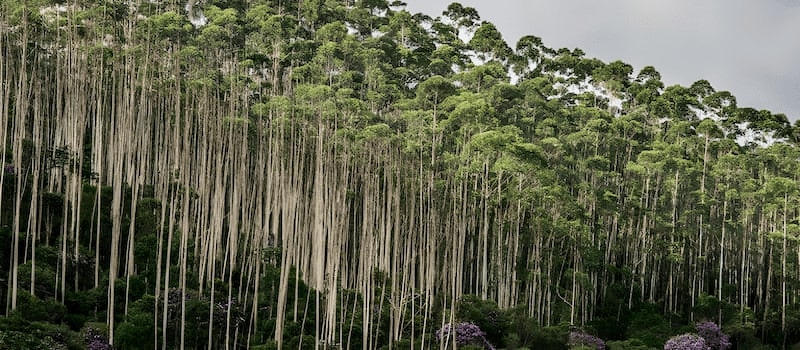
Growing Your Money Offshore
The USVI has established low-tax and no-tax business zones to encourage investment in the islands. One such zone is a rosewood tree plantation, which benefits from a climate well-suited for the growth of rosewood trees. Little water is required for irrigation and trees grow 20% faster due to the nutrient rich volcanic soil. Proprietary crop circle formations curl trees into a looping spiral that deflects the wind. The canopied spiral creates and holds humidity for optimal tree growth. Because trees are grown on U.S. protectorate soil, there is no ban on importing the wood to the mainland, providing investors with an opportunity to cultivate rosewood trees offshore and earn a profit from $46M revenue in year 40.
To qualify as a no-tax business zone the rosewood tree plantation is structured as social impact investment project funded by investor partners. Investment capital is secured by property ownership, which also provides an exit strategy. A portion of the capital raised is used to procure seed, propagation, transplanting, and provide periodic maintenance.
Growing Rosewood Trees, Seeds, Seedlings and Saplings
Rosewood trees are grown from seed sourced from mother rosewood trees that grow in the Amazon Rainforest. Approximately, 10,000 tree seeds are needed to grow 5,200 hundred rosewood tree seedlings assuming a 50% germination rate.
Rosewood seedlings are grown in a tree nursery built on site featuring proprietary pyramid pots, which encourage vertical trunk growth and a strong, ready for transplant root stem. Pyramid pots prevent blow down from wind blow, a common problem with trees grown in a conventional mainland nursery.
It takes about 20 days to germinate the seeds, which emerge as seedlings that grow into 3 year, 10-foot-tall tree saplings with the aid of proprietary fertilizing and pruning techniques.
Continuing to grow saplings for another 3 years to a height of 20 feet would shorten ROI from 40 to 30 years.
ROI – Return on Investment Growing Rosewood Trees
As one of the most expensive and sought-after exotic hardwoods in the world, the value of each rosewood tree would increase exponentially over time. For example, using a standing timber wood value of $8,896 per tree multiplied by 5,200 trees growing in the plantation creates a total value of $46,000,000 in year 40.
The Property, 56 Acres of Oceanfront
The plantation covers approximately 26 acres of a 56-acre ocean side property, which rises gently from the ocean to the first slopes an island mountain range.
Black Locust Tree Plantation
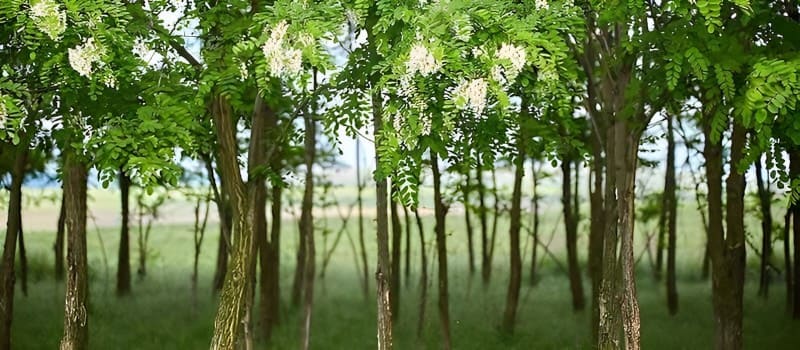
America's Super Tree
The Black Locust is America's super tree. It grows rot resistant wood, is harder than oak and features a grain that rivals walnut. Genetically predisposed to grow fast, it grows even faster in a geometrically shaped tree plantation. Looping spirals of locust trees spaced about 20 feet apart are harvestable in just 30 years and once cut, each stump grows a new tree becoming a sustainable and renewable resource. In terms of profitability, the wood is stronger than oak and more water resistant than cedar making black locust highly valued and marketable. Currently, there are no pure stand locust plantations in existence in America, which creates an opportunity to create the first black locust tree plantation in the country.
Black locust is characterized as a pioneer tree that grows fast and quickly establishes a shade canopy over the forest floor enabling different types of flora and fauna to arrive and thrive.
Growing Locust Trees from Seed
Black locust tree seedlings are grown from seed on site, propagated in 300-foot germination tunnels for 3 years or until they reach a height of 8 feet or more. The height protects the uppermost bud from deer that may graze through the plantation. The tall sapling, or whip as it is called, also ensures that the terminal bud remains high above the snowpack the first few years of the tree’s life.
Spiral Tree Planting
Black locust saplings are spaced around a spiraled 10,000-foot-long irrigation line 20 feet apart. Once transplanted, they grow quickly, often growing at a rate of 5 feet per year until they reach a height of 40 feet, when the growth rate declines by half. Planting 10-foot saplings creates an instant forest the second year after transplant and harvestable timber in year 30.
Capital Costs
A total of 30,000 trees are planted on a 100-acre site at a cost of $500,000, which excludes the cost of land. Plantation tree costs include the propagation of seeds to saplings over a 3-to-4-year period, site prep, fencing, transplant, and irrigation.
Capital Returns
In year 40, 30,000 black locust trees will be worth an average of $2,520 a tree and $756,000 an acre or $75,600,000 for the entire 100 acres providing the first 30 feet of trunk of each tree is clear of branches, which can be milled into long-length, wide plank, knot-free dimensions board and lumber.
Locust Plantation Location
A site has been selected near Vancouver, Washington not far from the Columbia River. The area has a perfect climate and soil for growing locust trees. The winters are short and mild, and humidly is high from coastal rain patterns and proximity to the river.
The 120-acre property, a former cattle ranch, will be planted with 36,000, 10-foot-tall black locust tree saplings.
Black Walnut Tree Plantation
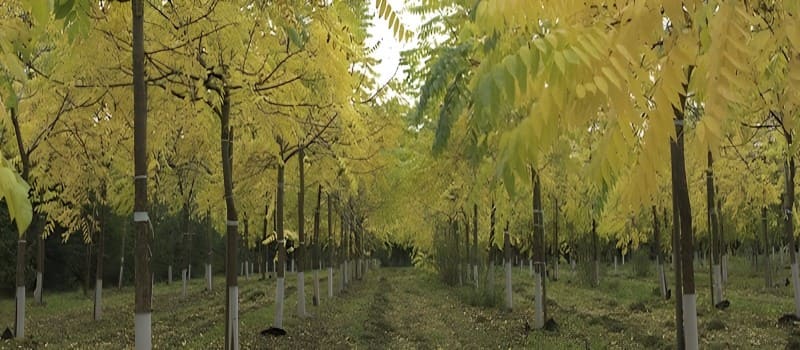
Black Walnut Wood, Sized and Prized
The scarcity of wide dimensional boards and top-grade veneer is due to the slow growth rate of a black walnut tree and the fact that they are not widely planted for commercial purposes. The supply of high-quality black walnut wood is limited because of this, which drives up its value and makes it a sought-after and expensive commodity. Black walnut is so valuable in fact, that large 100 plus year-old trees are stolen from farmers’ fields, cemeteries and city parks and sold on the lucrative exotic timber market each year. Wide dimension, knot-free boards are rare and almost unheard of, which makes investment in a black walnut tree plantation potentially very profitable. Knot-free, veneer quality sawlogs are also in high demand because of short supply.
Walnut wood is prized over English and Chinese walnut varieties because of its deep dark, rich textured wood.
Investing in a Black Walnut Tree Plantation
A concern for timber investors is return on investment (ROI), not whether they will make money but how much time it will take to make it. It can take up to 40 years or more to see a return for most hardwoods, 50 if you want to really want a big return. This is just one of the reasons Black Walnut is so valuable. Another is the rarity of large branch free trunks or sawlogs, so to achieve a faster and more profitable return on capital will require a new approach to growing trees.
Fallow land, land previously used to graze cattle is preferred for a black walnut plantation. Land like this is almost always flat and heavily manured from years of grazing. Because of this, land size is smaller, about 100 acres with a transplant tree density of around 200 trees per acre. Matured trees can be harvested in year 50 when individual trees are worth around $4,000 each for a total of $50M.
Growing Black Walnut Trees by the Tree Row
Designing a commercial hardwood tree plantation involves several factors that determines spacing between trees and distance between rows. These factors include the type of tree being planted, the intended use for the trees (e.g., timber production, conservation, or recreation), and the local climate and soil conditions.
In general, the spacing between trees and distance between rows for a hardwood tree plantation can range from 6 to 12 feet between trees and 10 to 20 feet between rows. This allows for efficient use of space permitting trees to grow to their full potential.
For species like black walnut, which have a larger leaf canopy than most hardwoods, more space between tree trees and rows is needed to produce higher-quality wood. In some cases, spacing may be as much as 25 to 30 feet between trees.
Black Walnut Spirals: Advantages of Mono-Cropping
A system of growing trees faster has been developed by Tree Plantation LLC in Florida. Black Walnut trees are spaced along either an Archimedean or Fibonacci spiral depending on whether the planation will be mono-cropped or mixed with different types of trees.
Mono-cropping trees spaced more or less uniformly throughout the plantation makes maintenance activities like pruning and culling easier and less problematic. Shadowing, where one tree shadows the one growing next to it, is virtually eliminate save the handful of trees that grow dominant and as such grow taller than the rest.
Mono-cropped trees also grow straighter because their trunks have no need to veer towards sunlight that filters through the plantation leaf canopy.
Mono-cropping black walnut trees can also allow for close proximity planting along and between rows.
Location, Cost & Profit
A follow farm in Tennessee will grow black walnut. The farm has a residence that will be used to house management along with several out-buildings to store equipment. Approximately 12,000 trees will be planted on 60 acres.
Seedlings will be grown from seed shells in raised berms where they will sprout and grow to be pruned to remove lateral branching. After 4 years, the 8-foot black walnut seedlings will be then transplanted on the farm.
Trees will continue to be pruned after transplant for a term of 20 years so as to create 30-foot tall, branch free trunk wood throughout the plantation.
Seed cost is estimated at $15,000 and will be sourced from old growth mother trees in Pennsylvania to ensure the best quality wood. A budget of $30,000 per annum is required to prune the trees.
Total profit at harvest is estimate at $36M in year 44.
White Pine Tree Plantation
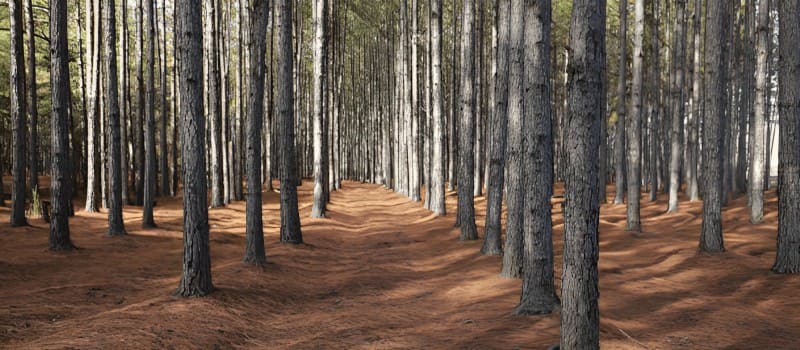
The Rarity of Long-Length, Wide-Plank, Clear-Grained Pine Wood
Long length, wide-plank, clear-grained pine wood is rare and hard to find because virtually all the “old-growth” trees were harvested long ago. Seemingly endless stands of white pine once grew in a 200-mile band that surrounded the Great Lakes. Many of these trees were over 300 feet tall and clear of branches most of the entire length of their trunks. The woof from these trunks were knot-free wood from these trees strong and resilient, perfect for the masts of French and English sailing ships. Only a few large specimens of this tree are found growing on private parkland, but these too may soon be gone.
A white pine tree harvested from an old growth forest today would be worth over $30,000 if you could find one. This presents an opportunity to grow branch free trunk wood for extraordinary profit.
Pine Pole Tree Plantations Growing Pole Wood
White pine can be found growing alongside red pine in commercial row-by-row tree plantations. Both pines are grown principally for pole wood, fence posts, and telephone poles. The wood harvested from pine pole plantations is of low quality because of the heavy branching the full length of the trunk of each tree. Each branch forms a knot, a biological imprint that is visible when the tree is milled, which makes wood from these trees less valuable.
Pine Plantation Alternatives
It can be several decades before branch-free pine trunks, are ready for harvest, which is often beyond the investment tolerance of most timber investors. A way increase tolerance is to grow tall pine tree saplings on site before transplant in the plantation. Using proprietary techniques to grow 10 foot tall, branch-free, white pine tree seedlings in just 5 years would shorten time to harvest by 10 years.
Using proprietary techniques to grow 10 foot tall, virtually branch-free, white pine tree seedlings in just 5 years would shorten time to harvest by a third.
Crop Circle Pine Plantations
Rather than growing trees in rows, Crop Circle Pine Plantations grow trees in geometric spirals, in which individual trees interconnect at the root to form a single living organism that can span several miles. The interconnection of tree roots has been scientifically shown to strengthen defense against pests and disease.
Pine Plantation Location, Cost & Profit
The plantation site is a repurposed farm that previously grew dent corn, located about 40 miles inland from Lake Huron, in Ontario, Canada. Formally tobacco country, the sand soil of the farm is ideal for growing white pine trees.
Approximately 30,000 pine seedlings will be purchased from the provincial forestry station and transplanted in 1,000-foot-long incubators where they will be manipulated to grow into 10-foot tall, branch-free, saplings.
After 5 years, they will be transplanted and pruned annually for another 15 years to create 30 to 40-foot-tall branch-free white pine tree trunks.
Forestry seedlings cost $30,000. The cost for incubation and manipulation costs $100,000. Field transplant costs in year 6 total $90,000. Annual pruning over 15 years costs around $300,000.
Total profit at harvest in year 40 totals $53M.
Paulownia Tree Plantation
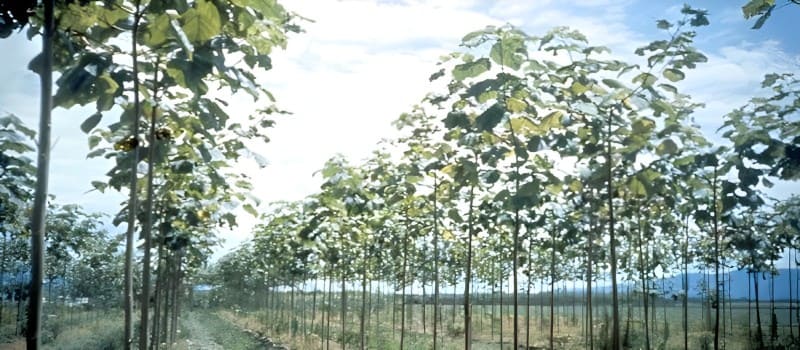
The 25-Year Journey to a 24-inch Diameter Tree
Paulownia is one of the fastest growing trees in the world. Paulownia can grow as much as 15 feet in a single season and reach maturity in as little as 7 years. This rapid growth makes it an attractive option for a paulownia tree plantation investment. Paulownia trees grow best in temperate and subtropical regions with warm, moist summers and mild winters. Left to size up in a plantation for 25 years, it can grow a 24-inch diameter, 30-foot-long branch free trunk with annual pruning. Paulownia wood is straight-grained, strong, and durable so large diameter sawlogs make great candidates for wide plank flooring. Quick harvest cycles create a sustainable wood resource in areas of the country suitable for this rapid growth.
Known as the ultimate coppicing tree, several new trees will grow from a cut stump after harvest. Selecting the tallest a month after coppicing and culling the rest will often grow a 20-foot leader in just a couple of years due of the trees established root system.
Paulownia Clones and Transplants
Paulownia plantations are created planting clones rather than sowing seed. Cloning can effectively produce large quantities of trees with desirable traits, such as disease resistance, rapid growth, or high timber yield. Paulownia tomentosa and elongata clones are most often selected for commercial timber production.
Paulownia Tree Care & Maintenance
Explosive growth rates can be attained with heavy watering and twice a year application of fertilizer. Main leader growth of 10 feet each year is not uncommon in ideal conditions. An annual branch trimming regime maximizes the value and profitability of the plantation.
Crop Circle Paulownia Tree Plantations
Crop Circle tree plantations grow Paulownia Empress Trees 20% faster than paulownia trees grown in parallel rows. The geometric form of the Crop Circle elongates the cellular structure of the tree increasing tree height without affecting wood quality or density. Tree harvesting and regrow cycles can be reduced by 3 years or more.
Site Location, Cost & Profit
The plantation site is located in the Carolinas where there is excellent atmospheric humidity, nutrient rich soil, a long hot growing season, and short winters but cold enough so the leaves drop in the fall.
To accommodate the spreading canopy of each tree, paulownia trees are spaced 25 feet apart populating each acre with approximately 200 trees. A 200-acre site therefore would grow 40,000 trees worth about $12M retail every 25 years. First year planting costs around $5 per tree, which includes the price of the tree and annual pruning, which averages $200 an acre.
Fruitwood Tree Plantation
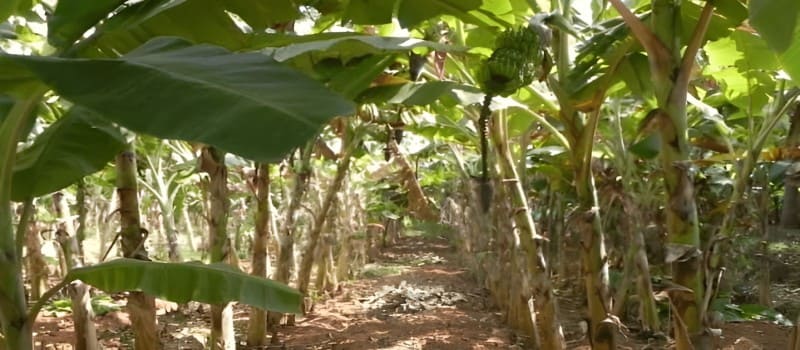
Fruitwood, The Most Profitable Hardwood in America
Today, the rarity of fruitwood commands prices typically paid for tropical hardwoods. Prices for pear wood dimensional lumber, particularly in long lengths is among some of the highest paid for any type of wood in the industry, including prices paid for tropical hardwoods like teak and mahogany. Fruitwood, also called Swiss Pear or European Pear is rarely found growing wild in nature where it can grow to 100 feet or more. A wild pear tree is usually a remnant of an old orchard or the result of a generational fly-over bird dropping. Some of these orphan pear trees have trunks over 10 feet across. The domesticated pear that grows in orchards was bred from some of these wild pear trees. Unlike the wild pear however, orchard pear trees are pruned each year to bear more fruit, which keeps the trunk of the tree short and the tree canopy close to the ground.
Long-length, dimensional fruitwood is milled from the wild pear found growing in Europe. This creates an opportunity to grow commercial fruitwood plantations in America. Pear wood, a variety of fruitwood, is more valuable than, teak, mahogany, black walnut, and virgin stand red wood.
Fruitwood Tree Farming
Single stalk, tall fruit tree seedlings called spears used to plant pear orchards can be used to plant a fruitwood tree plantation as well. Pear spears are about 6 feet tall and 5 years old and are custom ordered by variety, age, and height. Ideally, the older and taller the spear, the quicker the wood will be ready for harvest in the coming years. Tall Fruitwood tree seedlings are mechanically planted and manually pruned season to season to ensure that each tree develops a branch free trunk to a height of 30 feet or more by year 30. Pruning creates a clear-grained, veneer quality sawlog at harvest, which can be worth more than $10,000. Topping trees at 35 feet will increase trunk caliper by an average of 10% each year.
Spiral Tree Farming
Planting fruit trees along a spiral irrigation line creates the Crop Circle Fruit Tree Plantation, which grows trees 10% faster than a rowed tree farm. The spear saplings are planted 16 feet apart along the spiraled irrigation line, which is spaced 22 feet apart between loops within the spiral.
Location
The plantation site is located in the heart of pear country, Wenatchee, Washington on a 2 parcel 20-acre farm with one of the 10-acre parcels slated to grow fruitwood.
Cost & Profit
Two thousand fruitwood spears costing $5 each are planted on the 10 acres for a total of $100,000, which includes transplanting and irrigation costs. Thirty years of branch pruning costs $400,000. Total profit at harvest would top $20M in year 40.

